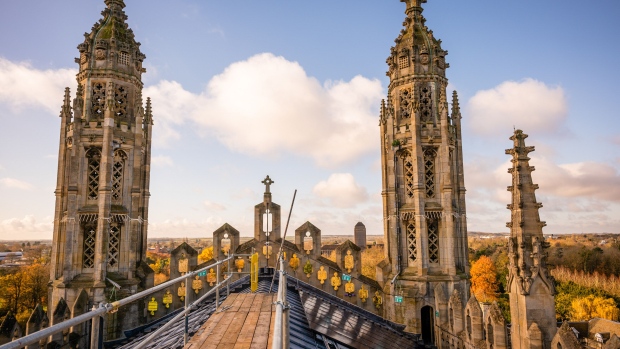Mar 29, 2024
A Historic British Chapel Is Powering Easter Service With Solar Energy
, Bloomberg News

(Bloomberg) -- The 500-year-old chapel at King’s College, Cambridge, is one of the most recognizable church buildings in Britain. Every year millions of viewers tune in to watch a candlelit Christmas service from the college’s choir, opened by a boy soprano who begins the carol Once in Royal David’s City with an angelic, piercing solo.
In the BBC’s TV broadcast, which has run regularly since 1963, the opening shot is an external view of the chapel, surrounded by the roofs and spires of Cambridge. That view has barely changed in 60 years — until now. Last year, the college began installing 438 solar panels on its roof, a highly visible and somewhat controversial symbol of change.
Now, as the college celebrates Easter this weekend, it can enjoy the completion of its ambitious work.
Gillian Tett, the provost of King’s College, says she hopes the project will help other churches “imagine what used to be unimaginable” and install solar panels themselves. Traditionally, Christian churches in Britain face east — meaning one side of their roofs is tilted to the south and positioned well for solar. The King’s College chapel has gone through many changes in its five-century history, she says, and this is just one more. “When King Henry VIII put the whole chapel up, no one could imagine having a chapel like this with all these extraordinary roofs, these gothic ceilings. It was impossible to visualize. And that’s kind of what we’re trying to do again.”
How do you make a building that has stood since pre-industrial times fit for a changing climate? The Church of England, with its 16,000 places of worship in the UK, has set a target for reaching net zero emissions by 2030. Starting small — LEDs, putting lights on timers and installing draught excluders — is often the way to go, says Graham Usher, the Bishop of Norwich and the Church of England’s lead bishop on the environment. “There’s lots of tiny changes that can be made,” he says. “And when they are made, they actually make quite a significant difference.”
Usher’s office has released “practical path” guidance for churches, which takes them through these steps. For instance, solar PV and heat pumps could be appropriate, but only in cases where churches are busy and well-used. First steps might include things like electric or infrared heaters, which sit underneath pews to heat people more efficiently rather than a whole building. There are also lower tech, cheaper solutions such as curtains, fabric hangings or panels over cold walls.
Usher says some Church of England churches — about 7% of the total — are already at net zero, largely because they are medieval buildings in rural areas without gas or electricity connections. Many churches are also used rarely. On the other end of the spectrum, the biggest emitters, which also tend to be the busiest, most-used buildings, are often located in cities, heated with gas and used regularly, not just for church services but for playgroups, coffee mornings, exhibitions and events. They may also house offices, and may not be particularly old, although newer buildings are a minority — less than 10% of the church’s buildings are from the 20th century.
Changes to church buildings spark wider conversations about what churches are for, and what they’re supposed to look like, especially when visible, historic or beloved buildings are involved. At King’s College, Tett said the original announcement about the solar roof project generated critique in some quarters of the press.
Usher acknowledged the struggle churches face when trying to advance such projects — as they take care to not cause harm to buildings or attract legal or public challenges from heritage groups. “There has been a tendency by some to want to treat our ancient buildings, in aspic, not change anything,” he says. “In a well-loved church, just changing pews to seats can cause challenges.”
But this is changing, he adds, partly because of guidance, which helps churches put their plans together in a way that doesn’t ruffle as many feathers, and also because of new rules that put greater emphasis on climate-proofing. The blog Law & Religion UK keeps an unofficial catalog of judgments in the ecclesiastical courts, which decide whether churches can make big changes to their buildings. It records very few refusals for low-carbon heating systems or solar panels. In some cases, the courts have asked churches to re-consider plans to install new gas or oil boilers, on the grounds that cutting emissions is now a priority.
The Church of England has also made headlines for its divestments from the fossil fuel industry. Both aspects — the buildings and the investment strategy — are ultimately motivated by faith, Usher says. He adds the church is also part of a wider network — the Anglican Communion — which has many members in some of the countries worst-hit by climate change, including sub-Saharan Africa and Asia.
“We believe as Christians that the world is God’s gift,” Usher says, “and that we are called as human beings to steward that gift, to take care of that gift, pass that gift on.”
©2024 Bloomberg L.P.


